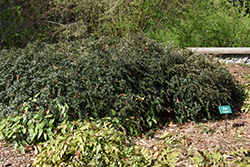Fri & Sat 8am - 8pm
Sun 8am - 7pm
Anytown, USA 12345
fax: 261.787.0463
e-mail: info@successgc.com


Plant Finder

Height: 3 feet
Spread: 5 feet
Sunlight:
![]()
![]()
Hardiness Zone: 5b
Other Names: Pale-leaved Barberry
Description:
An evergreen, dwarf shrub with a mounded habit with arching, spiny branches; dark green, shiny leaves with blue-white undersides take on bronze-red tones in winter; pretty yellow flowers along the branches in spring; an excellent, spreading groundcover
Ornamental Features
Paleleaf Barberry is clothed in stunning clusters of yellow pea-like flowers along the branches from late spring to early summer. It has attractive dark green foliage with silvery blue undersides. The small glossy pointy leaves are highly ornamental and turn outstanding shades of coppery-bronze and in the fall, which persists throughout the winter. The fruits are showy deep purple drupes with hints of powder blue and which fade to black over time, which are displayed from early to late fall. The tan stems can be quite attractive.
Landscape Attributes
Paleleaf Barberry is a dense multi-stemmed evergreen shrub with a mounded form. Its relatively fine texture sets it apart from other landscape plants with less refined foliage.
This shrub will require occasional maintenance and upkeep, and can be pruned at anytime. Deer don't particularly care for this plant and will usually leave it alone in favor of tastier treats. Gardeners should be aware of the following characteristic(s) that may warrant special consideration;
- Suckering
- Spiny
Paleleaf Barberry is recommended for the following landscape applications;
- Mass Planting
- Rock/Alpine Gardens
- General Garden Use
- Groundcover
- Naturalizing And Woodland Gardens
- Container Planting
Planting & Growing
Paleleaf Barberry will grow to be about 3 feet tall at maturity, with a spread of 5 feet. It tends to fill out right to the ground and therefore doesn't necessarily require facer plants in front. It grows at a slow rate, and under ideal conditions can be expected to live for approximately 30 years.
This shrub does best in full sun to partial shade. It does best in average to evenly moist conditions, but will not tolerate standing water. This plant will benefit from an application of bonemeal and/or mycorrhizal fertilizer at the time of planting. It is not particular as to soil type, but has a definite preference for acidic soils, and is subject to chlorosis (yellowing) of the foliage in alkaline soils. It is highly tolerant of urban pollution and will even thrive in inner city environments, and will benefit from being planted in a relatively sheltered location. This species is not originally from North America.
Paleleaf Barberry makes a fine choice for the outdoor landscape, but it is also well-suited for use in outdoor pots and containers. Because of its height, it is often used as a 'thriller' in the 'spiller-thriller-filler' container combination; plant it near the center of the pot, surrounded by smaller plants and those that spill over the edges. It is even sizeable enough that it can be grown alone in a suitable container. Note that when grown in a container, it may not perform exactly as indicated on the tag - this is to be expected. Also note that when growing plants in outdoor containers and baskets, they may require more frequent waterings than they would in the yard or garden.
